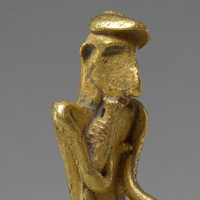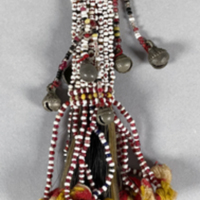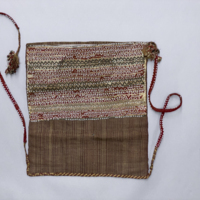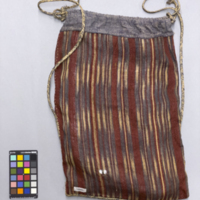Gold Figure
Text
Figure of a female deity (?) seated cross-legged, made of 21 carat gold. It has a richly ornamented head-dress and many ornaments on th arms and other parts of the body. ( Francisco 1963: 390)
Gold image of a Hindu deity, probably of Javanese workmanship, and representing Shiiva's wife Parvati? or more probably Bodhisativa (Copied from Field Museum card catalog) Notes: See Accession jacket for information re: published material on this specimen, including reprint of 1963 article by Juan R. Francisco.
Technical Description: Agusan image; Field Museum Catalogue Number: 109928
Share this
Media
Images
Documents
| Name | Info | Actions |
|---|---|---|
| A Note on the Golden Image_ Francisco.pdf | pdf / 1.44 MB | Download |
Map The Field Museum of Natural History
Metadata
Date
Possibly more than 1,000 years old,
Identifier
FIELD-1010530
Origin
Agusan, Mindanao
This was found in 1917 on the left bank of the Wawa River near Esperanza, Agusan, eastern Mindanao, following a storm and flood.
This was found in 1917 on the left bank of the Wawa River near Esperanza, Agusan, eastern Mindanao, following a storm and flood.
Materials
metal; gold, metal; copper, metal; silver
Physical Dimensions
Height: 17.2 cm width: 9.3 cm length: 4.5 cm
4.4 lb
4.4 lb
Provenance
S. Mathews [1060] Second R.F. Cummings Ethnological Expedition to Philippine Islands - ethnology - Mangyan (Expedition) Accession number: 1404( from Field Museum site 2021)
News of its existence eventually reached important people such as Louise Wood, whose husband Leonard Wood served as American governor-general in the Philippines. Fearing that the image might be melted down for its value in gold, Mrs. Wood conducted a fundraising campaign to collect funds for the purchase of the gold artifact. She enlisted the help of Fay-Cooper Cole, the curator of Chicago Field Museum's Southeast Asian department, together with Shaler Matthews, a professor at the University of Chicago, for the fundraising campaign. Their efforts paid off when the image was finally acquired for the museum in 1922 for ₱4,000.00. The image was then shipped to the United States in 1922 and was finally housed at the Field Museum of Natural History in Chicago, where it is still stored up to this day. (Capistrano-Baker 2011: 262).
News of its existence eventually reached important people such as Louise Wood, whose husband Leonard Wood served as American governor-general in the Philippines. Fearing that the image might be melted down for its value in gold, Mrs. Wood conducted a fundraising campaign to collect funds for the purchase of the gold artifact. She enlisted the help of Fay-Cooper Cole, the curator of Chicago Field Museum's Southeast Asian department, together with Shaler Matthews, a professor at the University of Chicago, for the fundraising campaign. Their efforts paid off when the image was finally acquired for the museum in 1922 for ₱4,000.00. The image was then shipped to the United States in 1922 and was finally housed at the Field Museum of Natural History in Chicago, where it is still stored up to this day. (Capistrano-Baker 2011: 262).
Acquisition Date
Purchased by the Field Museum in 1922 for ₱4,000.00.
Short description
A study of this image was made by F. D. K. Bosch, of Batavia, in 1920, who came to the conclusion that it was made by local workmen in Mindanao, copying a Nganjuk image of the early Majapahit period - except that the local artist overlooked the distinguishing attributes held in the hand. It probably had some connection with the Javanese miners who are known to have been mining gold in the Agusan-Surigao area in the middle or late 14th century. The image is apparently that of a Sivaite goddess, and fits in well with the name "Butuan" (signifying "phallus"). (H. Otley Beyer, 1947)
Display status
On display in the Gold Room of the Chicago Museum of Natural History.
References
H. Otley Beyer, "Outline Review of Philippine Archaeology by Islands and Provinces," Philippine Journal of Science, Vol.77, Nos.34 (July–August 1947), pp. 205-374
Francisco, Juan R. (1963). "A Note on the Golden Image of Agusan". Philippine Studies. 11 (3): 395. ISSN 0031-7837. JSTOR 42719871
Capistrano-Baker, Florina H; Guy, John; Miksic, John N (2011). "The Aqusan lmaqe in the Field Museum of Natural History (Jamie Kelly)". Philippine ancestral gold. Ayala Foundation; NUS Press. p. 262.
[Book] de Monbrison, Constance & Alvina, Corazon S. 2013. Philippines: An Archipelago of Exchange.
Francisco, Juan R. (1963). "A Note on the Golden Image of Agusan". Philippine Studies. 11 (3): 395. ISSN 0031-7837. JSTOR 42719871
Capistrano-Baker, Florina H; Guy, John; Miksic, John N (2011). "The Aqusan lmaqe in the Field Museum of Natural History (Jamie Kelly)". Philippine ancestral gold. Ayala Foundation; NUS Press. p. 262.
[Book] de Monbrison, Constance & Alvina, Corazon S. 2013. Philippines: An Archipelago of Exchange.
Acknowledgements
Courtesy of: J. Weinstein. (c) Field Museum of Natural History. CC BY-NC 4.0. https://mm.fieldmuseum.org/2294b496-7b33-427e-bbb7-970a86f83608 (accessed on 13 Oct 2021); Courtesy of: Ron Testa and Diane Alexander White. (c) Field Museum of Natural History. CC BY-NC 4.0. https://mm.fieldmuseum.org/5ae48246-1a36-4324-ba13-b9da24699509 (accessed on 27 Oct 2021); Courtesy of: J. Weinstein. (c) Field Museum of Natural History. CC BY-NC 4.0. https://mm.fieldmuseum.org/ac3451fa-e81f-4459-861d-5dea3cf6d41c (accessed on 22 Aug 2021); Courtesy of: J. Weinstein. (c) Field Museum of Natural History. CC BY-NC 4.0. https://mm.fieldmuseum.org/2d180810-56a8-41f1-a393-f1cbfb16d567 (accessed on 22 Aug 2021); Courtesy of: Ron Testa and Diane Alexander White. (c) Field Museum of Natural History. CC BY-NC 4.0. https://mm.fieldmuseum.org/399e599c-d6c0-4149-87cc-870ba9188a1d (accessed on 27 Oct 2021); Courtesy of: J. Weinstein. (c) Field Museum of Natural History. CC BY-NC 4.0. https://mm.fieldmuseum.org/8649c338-d43c-4ca1-9534-214d734c9a5a (accessed on 22 Aug 2021); Courtesy of: Ron Testa and Diane Alexander White. (c) Field Museum of Natural History. CC BY-NC 4.0. https://mm.fieldmuseum.org/fa4be186-ccdb-4974-b178-3a64e95a21a5 (accessed on 29 Oct 2021); Courtesy of: Ron Testa and Diane Alexander White. (c) Field Museum of Natural History. CC BY-NC 4.0. https://mm.fieldmuseum.org/aaae477e-23cf-4e28-b924-ba4c5d4a4854 (accessed on 27 Oct 2021); Courtesy of: F. Cole. (c) Field Museum of Natural History. CC BY-NC 4.0. https://mm.fieldmuseum.org/ffdc80e6-22eb-4e40-a950-ca10d78fed02 (accessed on 26 Oct 2021); (c) Field Museum of Natural History. CC BY-NC 4.0. https://mm.fieldmuseum.org/69c3ae74-8a73-42c8-868a-84bfa988d7cb (accessed on 28 Sep 2021); (c) Field Museum of Natural History. CC BY-NC 4.0. https://mm.fieldmuseum.org/56d6d331-4592-487d-8b2f-7db25e4e90c8 (accessed on 26 Oct 2021); Courtesy of: R. Testa. (c) Field Museum of Natural History. CC BY-NC 4.0. https://mm.fieldmuseum.org/08d6cd9f-a69a-4555-9d5a-66f780f3b05c (accessed on 19 Jul 2021); Courtesy of: R. Testa. (c) Field Museum of Natural History. CC BY-NC 4.0. https://mm.fieldmuseum.org/32b2c165-ddcd-4d4d-9b92-efbcb707dbf3 (accessed on 19 Jul 2021); Courtesy of: R. Testa. (c) Field Museum of Natural History. CC BY-NC 4.0. https://mm.fieldmuseum.org/923cd3b4-2e12-442b-9024-0844cf2d59d2 (accessed on 19 Jul 2021); Courtesy of: J. Weinstein. (c) Field Museum of Natural History. CC BY-NC 4.0. https://mm.fieldmuseum.org/3b194f0a-dc16-4b62-a60c-f6f380f2dd90 (accessed on 07 Nov 2021); Courtesy of: J. Weinstein. (c) Field Museum of Natural History. CC BY-NC 4.0. https://mm.fieldmuseum.org/0ad8cea9-fc00-4c8d-be1b-7a19f71baa90 (accessed on 07 Nov 2021); Courtesy of: S. Carlson. (c) Field Museum of Natural History. CC BY-NC 4.0. https://mm.fieldmuseum.org/4870fa8d-74d8-42cd-9dd8-3328117629e4 (accessed on 23 Sep 2021); c8d66fd5-2685-4138-8adb-8476c6c0f8ec; b873c18c-d2e9-4421-9aa6-2f199febca52; 75eaf17e-f0c2-458b-b771-3abc210fe240; 630019eb-2537-4efb-9d4f-397caafcb800; Courtesy of: R. Testa. (c) Field Museum of Natural History. https://mm.fieldmuseum.org/630019eb-2537-4efb-9d4f-397caafcb800 (accessed on 29 Oct 2021)
Official Website
Collection
Cite this Page
“Gold Figure,” Mapping Philippine Material Culture, accessed April 20, 2024, https://philippinestudies.uk/mapping/items/show/6107.
Geolocation
Sensitive Content
Mapping Philippine Material Culture collates digital material from institutions, and some of this material is inherently colonial and contains words, terms and phrases that are inaccurate, derogatory and harmful towards Filipino and Filipino diasporic communities. Catalogue transcriptions, book titles, exhibition titles and museum titles may contain harmful terms. We recognise the potential for the material to cause physical and mental distress as well as evoke strong emotions. Owing to the scale of the collection’s data, a process to implement sensitive-content warnings in the displayed data is still incomplete. The material within the catalogue does not represent Mapping Philippine Material Culture’s views. Mapping Philippine Material Culture maintains a strong anti-colonial, anti-racist position and affirms its support for centring the humanity of historically marginalised and disenfranchised communities.
Facebook Twitter



